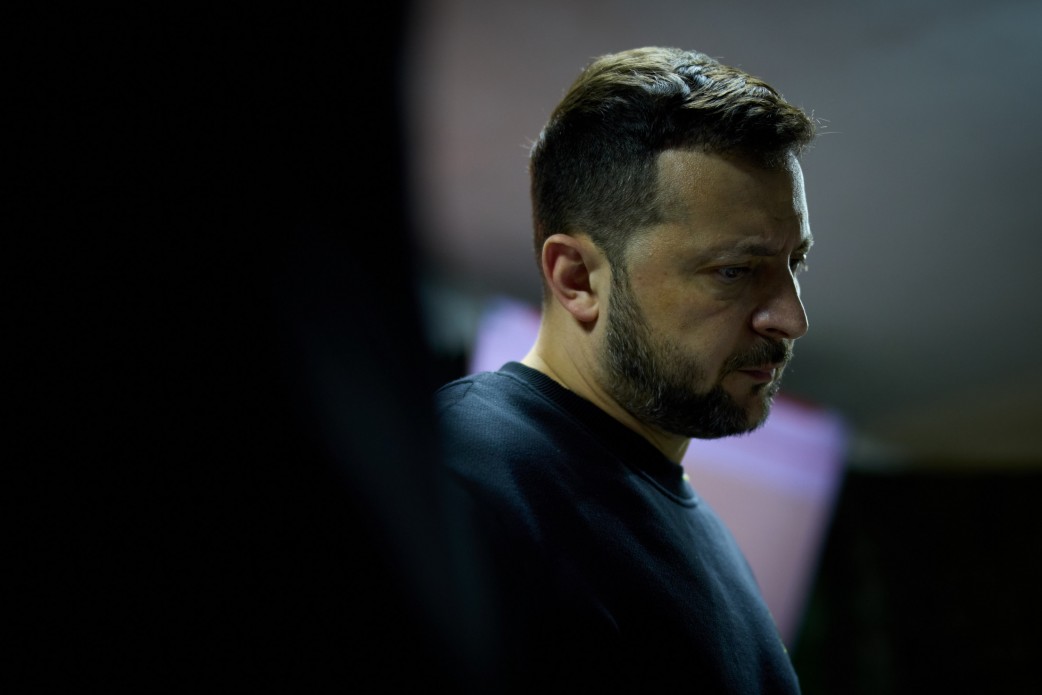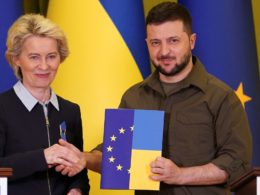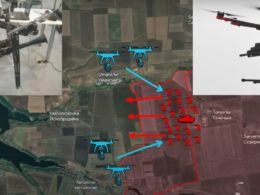On 15 June, over 100 countries are set to gather in Switzerland for a highly anticipated peace summit aimed at ending the devastating war Russia has been waging against Ukraine since February 2022.
However, the event that was supposed to be a powerful display of global support for Ukraine now risks turning into a diplomatic setback for Kyiv, a leaked draft resolution indicates.
The summit in Lucerne was initially conceived as a way to rally the international community behind Ukrainian President Volodymyr Zelenskyy’s 10-point peace plan, which he presented to the world in November 2022. The formula was meant to serve as the blueprint for negotiations to end the conflict on terms favorable to Ukraine.
Zelenskyy’s 10-point peace formula: a roadmap to end the war
At the heart of the Swiss peace summit was meant to be President Zelenskyy’s comprehensive peace plan, which he first unveiled at the G20 summit in November 2022.
The 10-point formula outlined Ukraine’s vision for ending the war and restoring its sovereignty and territorial integrity. Its key provisions include:
- Radiation and nuclear safety, focusing on protecting Europe’s largest nuclear power plant in Zaporizhzhia, Ukraine.
- Food security, including safeguarding and ensuring Ukraine’s grain exports to the world market.
- Energy security, with a focus on price restrictions on Russian energy resources.
- Release of all prisoners and deportees, including war prisoners and children deported to Russia.
- Restoring Ukraine’s territorial integrity and Russia reaffirming it according to the UN Charter.
- Withdrawal of Russian troops and cessation of hostilities, with all parties agreeing to a UN-supervised ceasefire.
- Restoring justice, including establishing a special tribunal to prosecute Russian war crimes.
- Anti-ecocide, aiming to protect the environment and asking Russia to compensate the damage.
- Preventing escalation by strengthening Euro-Atlantic security architecture.
- Confirming the end of the war with all sides signing a document.
Ukraine’s diplomatic corps had worked tirelessly to build international consensus around this plan, insisting that without a Russian troop pullout from Ukraine’s internationally recognized borders, there can be no lasting peace.
Two summits have been held:
- in Jeddah, Saudi Arabia in August 2023, hailed as a breakthrough thanks to the participation of China (which later nevertheless withdrew and ramped up its support to Russia’s war);
- in Malta in October 2023, in which Ukraine’s efforts revolved around the Global South and saw the number of participants rising to 66 from 40.
In preparation for the summits, Ukraine held many consulations: the inaugural meeting in Copenhagen (June 2023) and Davos (January 2024).
Bolstering international backing for the Peace Formula has been a central effort of President Zelenskyy’s administration.
He stated in December 2023 that the initiative was now supported by “over 80” countries. The plan itself was endorsed by the Council of Europe, the EU, G7, and single countries in separate documents, among which are the UK, Poland and Lithuania, and others.
The Swiss summit is slated to gather 106 countries, according to Zelenskyy.
Ukrainian peace formula no longer exclusive
Zelenskyy and his team recognized that not every country would endorse every point. So they devised a flexible approach where different countries could sign onto the specific elements of the plan they supported, without necessarily backing the formula in its entirety.
The strategy appeared to pay off. Many countries, including key EU members, publicly declared the Zelenskyy plan to be the only viable path to peace. The idea was that by the time the Switzerland summit rolled around, Ukraine would have a broad coalition rallied behind its vision, ready to present a united front to Russia.
But with the release of the summit’s draft joint declaration, obtained by the Ukrainian media European Pravda and Bloomberg, it appears that Zelenskyy’s peace formula has been significantly watered down.
Instead, the draft declaration now states that the summit participants will be guided by the “Ukrainian peace formula and other peace proposals,” effectively placing plans put forward by countries like China and the African Union on equal footing with Zelenskyy’s.
This is a far cry from what Kyiv had originally envisioned. Previously “alternative” peace plans had been marginalized, not promoted.
Alternative “peace plans” for Russo-Ukrainian war
Zelenskyy’s office has repeatedly emphasized the importance of an exclusively Ukrainian-led peace plan, rejecting foreign peace plans put forward since Russia’s full-scale invasion:
- China’s peace plan. On 24 February 2023, the Chinese Foreign Ministry published 12-point “peace” proposals to resolve Russia’s war against Ukraine, which while expressing respect for the territorial integrity of states, has called to deescalate the situation, a “political regulation of the conflict” and a ceasefire. This plan was received with suspicion by the European Commission, whose Vice-President Frans Timmermans stressed that “If we move away from respecting borders, hell will break loose throughout the world.”
- The African peace plan, expressed by South African President Cyril Ramaphosa during the visit of an African delegation to Kyiv, calls for a de-escalation of the situation, negotiations, and the need for security guarantees for “all countries.” Ukrainian President Zelenskyy rejected the plan as leading to another frozen conflict like the failed Minsk negotiations, stating that “peaceful negotiations with Russia are only possible after the withdrawal of Russian forces from the occupied territories.”
- Vatican plan. On 5 June 2023, the Vatican sent an envoy to Ukraine to explore potential paths to peace. While no concrete plan has been expressed, Pope Francis has repeatedly made calls for a ceasefire and negotiations without mentioning the need for Russia’s withdrawal from Ukraine, and urged Ukraine to raise the white flag.
- Indonesia has also suggested a peace plan to freeze the conflict and hold referendums in the occupied territories.
Ukraine maintains that any proposals for a ceasefire and negotiations with Russia will result in repeating the 2015 Minsk peace agreements. This deal, which Germany and France brokered with Ukraine and Russia, saw Russia’s invasion of eastern Ukraine frozen for eight years and the territories it occupied legitimized as “republics.” Russia had no intention of peace: it launched a full-scale invasion in 2022.
Three points of Zelenskyy’s plan instead of ten
No less concerning for Ukraine is what has been omitted from the summit’s agenda.
Initially, the idea was to have countries break out into nine working groups to hammer out concrete roadmaps for implementing each of the 10 points of Zelenskyy’s plan. Then these nine mechanisms would be combined into a large comprehensive plan with ultimatum demands to Russia, and at this stage Russia could be invited to the conversation with a demand to implement the plan developed by the international community, European Pravda writes, referring to the first draft of the summit communiqué which Ukraine submitted to Switzerland in April.
The current draft has no mention of this: under pressure from Bern and other capitals, this plan was completely revised.
Instead, to “facilitate consensus building,” the summit is now set to focus on just three issues – nuclear safety, food security, and prisoner swaps — three points that Zelenskyy has earlier said is supported by countries that are not entirely on Ukraine’s side.
Zelenskyy defined three main points in the Peace Formula, supported even by those countries that “balance” between Ukraine and Russia in their war stance.
The 3 points are:
1) nuclear safety
2) food safety
3) humanitarian direction (exchange of POWs and return of Ukrainian… pic.twitter.com/ziuQjcVk9E— Euromaidan Press (@EuromaidanPress) May 28, 2024
While these points are certainly important and are part of the Ukrainian formula, they are not seen as being directly tied to achieving an overarching peace deal. Some fear this narrowing of focus could provide Russia an opening to shape the future peace framework in its favor, according to European Pravda editor-in-chief Serhiy Sydorenko.
The question of Russia’s participation
Kyiv has previously acknowledged that at some stage, Moscow will need to be brought to the table, not least because many points of the peace plan cannot be implemented without Russian participation.
However, Ukraine had envisaged a structured process that would not threaten to undermine its interests. The idea was that world leaders would first agree on a sequence of steps, including applying pressure on Moscow, that could potentially lead to a cessation of hostilities and a withdrawal of Russian troops, while also ensuring nuclear, food, and energy security for the region.
Only after this consensus was reached would intermediaries, on Ukraine’s behalf, begin communicating with Russia, “forcing” it to peace. And crucially, Russian representatives would be invited to the Peace Summit only after Moscow agreed to act within this pre-agreed framework.
This has now been undermined, according to European Pravda.
During the editing of the summit’s draft declaration, this sequence was deleted, while the goal of Russia’s eventual inclusion remained. Now, for Russia to become a participant in the process, it is enough to conduct negotiations on “nuclear issues,” food supplies, and prisoner exchanges.
“We have agreed to take concrete steps that will become confidence-building measures (between Ukraine and the Russian Federation) in the above-mentioned areas, with the subsequent involvement of representatives of the Russian Federation (in the negotiations). We also agreed to hold the next summit,” the draft decision cited by European Pravda reads.
Sydorenko argues that Ukraine’s insistence on holding the summit this year, before all the necessary conditions were in place, was a strategic blunder. He contends that no one was pressuring Kyiv to move ahead with the meeting, and that by pushing for it prematurely, Ukraine has squandered the diplomatic victory it achieved last year in cementing its peace formula as the basis for negotiations.
At this late hour, with the summit just days away, cancelling the event is viewed as unrealistic. Ukraine still has the option of refusing to sign onto the final joint communique if it feels its core principles have been compromised, European Pravda says.
The stakes for Ukraine at the summit couldn’t be higher. While it has succeeded in rallying a broad international coalition to its side, it remains unclear how many of the countries gathering in Switzerland are willing to fully endorse Ukraine’s vision for peace. Kyiv may have to decide what concessions it can accept in the Declaration text, and what lines it is unwilling to cross.
Russia, meanwhile, will likely be watching the developments in Switzerland with great interest. Moscow has already hinted it may organize an “alternative” peace summit of its own. The risk is that the Swiss meeting, if not managed adroitly, could lend unintended legitimacy to the Russian initiative.
In many ways, the Switzerland summit has become a high-stakes diplomatic battleground, with the future contours of the Russia-Ukraine peace process hanging in the balance.
The coming days will test Ukraine’s ability to hold the line on its peace formula and keep its hard-won international coalition united. If Kyiv succeeds, it could emerge from Switzerland with its diplomatic hand strengthened. But if the summit fails to decisively endorse Ukraine’s approach, it risks breathing new life into alternative peace proposals that Kyiv views as anathema to its interests. For Zelenskyy, it may be the diplomatic challenge of a lifetime.
Related:
- Zelenskyy expects a three-point action plan from the upcoming peace summit in Switzerland
- Xi Jinping begins first European tour in five years in France with Russia’s war, EU trade at top of his agenda
- Switzerland Peace Summt on Ukraine to present unified negotiations terms to Russia – Zelenskyy’s spokesperson
- Zelenskyy unveils agenda for upcoming Global Peace Summt in Switzerland










